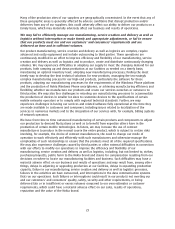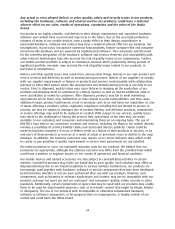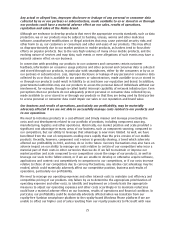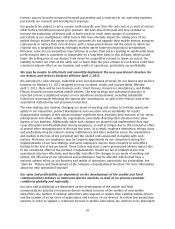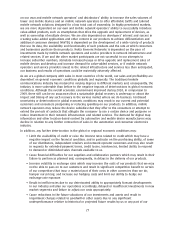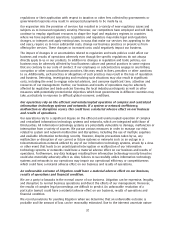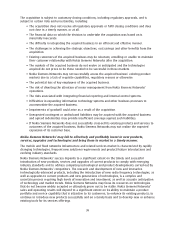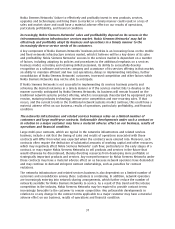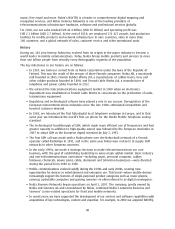Nokia 2010 Annual Report Download - page 32
Download and view the complete annual report
Please find page 32 of the 2010 Nokia annual report below. You can navigate through the pages in the report by either clicking on the pages listed below, or by using the keyword search tool below to find specific information within the annual report.business and results of operations. See Item 4B. “Business Overview—Devices & Services—Patents and
Licenses”; “—NAVTEQ—Patents and Licenses”; and “—Nokia Siemens Networks—Patents and
Licenses” for a more detailed discussion of our intellectual property activities.
Our sales derived from, and assets located in, emerging market countries may be materially
adversely affected by economic, regulatory and political developments in those countries or
by other countries imposing regulations against imports to such countries. As sales from
those countries represent a significant portion of our total sales, economic or political turmoil
in those countries could materially adversely affect our sales and results of operations. Our
investments in emerging market countries may also be subject to other risks and
uncertainties.
We generate sales from and have manufacturing facilities located in various emerging market
countries. Sales from those countries represent a significant portion of our total sales and those
countries represent a significant portion of any expected industry growth. Accordingly, economic or
political turmoil in those countries could materially adversely affect our sales and results of
operations and the supply of devices and network infrastructure equipment manufactured in those
countries. Further, the economic conditions in emerging market countries may be more volatile than
in developed countries and the purchasing power of our customers and consumers in those countries
depends to a greater extent on the price development of basic commodities and currency fluctuations
which may render our products too expensive to afford. Our business and investments in emerging
market countries may also be subject to risks and uncertainties, including unfavorable or
unpredictable taxation treatment, exchange controls, challenges in protecting our intellectual
property rights, nationalization, inflation, currency fluctuations, or the absence of, or unexpected
changes in, regulation as well as other unforeseeable operational risks. For example, Nokia Siemens
Networks, as well as its competitors, were adversely affected in 2010 by the implementation of
security clearance requirements in India which prevented the completion of product sales to
customers, and could be similarly affected again in 2011, leading to ongoing uncertainty in that
market. See Note 2 to our consolidated financial statements included in Item 18 of this annual report
for more detailed information on geographic location of net sales to external customers, segment
assets and capital expenditures.
Changes in various types of regulation and trade policies as well as enforcement of such
regulation and policies in countries around the world could have a material adverse effect on
our business and results of operations.
Our business is subject to direct and indirect regulation in each of the countries in which we, the
companies with which we work and our customers do business. We develop many of our products
based on existing regulations and technical standards, our interpretation of unfinished technical
standards or there may be an absence of applicable regulations and standards. As a result, changes in
various types of regulations, their application and trade policies applicable to current or new
technologies or products may adversely affect our business and results of operations. For example,
changes in regulation affecting the construction of base stations and other network infrastructure
could adversely affect the timing and costs of new network construction or expansion and the
commercial launch and ultimate commercial success of those networks. Export control, tariffs or other
fees or levies imposed on our products and environmental, product safety and security and other
regulations that adversely affect the export, import, pricing or costs of our products could also
adversely affect our sales and results of operations. For example, copyright collecting societies in
several member states of the EU as well as in several other countries claim that due to their
capability to play and store copyrighted content, mobile devices should be subject to similar
copyright levies that are charged for products such as compact disc, digital video disc or digital audio
players. Any new or increased levies and duties could result in costs which lead to higher prices for
our products, which may in turn impair their demand. In addition, changes in various types of
31




